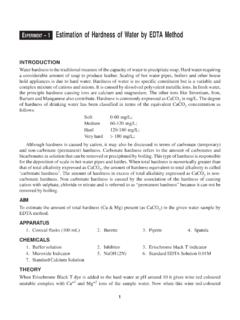Transcription of 05. COMPLEXOMETRIC TITRATION.ppt
1 COMPLEXOMETRIC . TITRATION. An application method of Inorganic Pharmaceutical Analysis Lecturer : Dr. Tutus Gusdinar Pharmacochemistry Research Group School of Pharmacy INSTITUT TEKNOLOGI BANDUNG. COMPLEXOMETRIC titration is a type of titration based on complex formation between the analyte and titrant. COMPLEXOMETRIC titrations are particularly useful f l ffor determination d t i ti off a mixture i t off different metal ions in solution. An indicator with a marked color change is usually used to detect the end-point end point of the titration. Any complexation reaction can in theory be applied as a volumetric technique provided that : the reaction reaches equilibrium rapidly following each addition of titrant.
2 Interfering situations do not arise (such as stepwise formation of various complexes resulting in the presence of more than one complex in solution in significant concentration during the titration process). process). an COMPLEXOMETRIC indicator capable of locating equivalence point with fair accuracy is available I practice, In ti the th use off EDTA as a tit titrantt iis well ll established. t bli h d COMPLEXOMETRIC titration with EDTA. Ethylenediamminetetraacetic acid, has four carboxyl groups and two amine groups that can act as electron pair donors donors, or Lewis bases. The ability of EDTA to potentially donate its six lone pairs of electrons for the formation of coordinate covalent bonds to metal cations makes EDTA a hexadentate ligand.
3 However in practice EDTA is usually only partially ionized However, ionized, and thus forms fewer than six coordinate covalent bonds with metal cations Disodium EDTA. cations. EDTA, commonly used in the standardization of aqueous solutions of transition metal cations, only forms four coordinate covalent bonds to metal cations at pH values less than or equal to 12 as in this range of pH values the amine groups remain protonated and thus unable to donate electrons to the formation of coordinate covalent bonds. In analytical chemistry the shorthand "Na2H2Y" is typically used to designate disodium EDTA. This shorthand can be used to designate any species of EDTA.
4 The "Y" stands for the EDTA molecule, and the "Hn" designates the number of acidic protons bonded to the EDTA molecule. EDTA forms an octahedral complex with most 2+ metal cations M2+, in aqueous solution cations, solution. The main reason that EDTA. is used so extensively in the standardization of metal cation solutions is that the formation constant for most metal cation- EDTA complexes is very high, meaning that the equilibrium for the reaction : M2+2 + H Y MH Y + 2H+. 4 2. lies far to the right. Carrying out the reaction in a basic buffer solution removes H+ as it is formed formed, which also drives the reaction to the right. For most purposes it can be considered that the formation of the metal cation-EDTA complex p g goes to completion, and this is chiefly why EDTA is used in titrations /.
5 Standardizations of this type. To carry outt metal T t l cation ti titrations tit ti using i EDTA it is i almost l t always necessary to use a COMPLEXOMETRIC indicator, usually an organic dye such as Fast Sulphon Black, Black Eriochrome Black T, Eriochrome Red B or Murexide, to determine when the end point has been reached. These dyes bind to the metal cations in solution to form colored complexes. comple es However, Ho e er since EDTA binds to metal cations much more strongly than does the dye used as an indicator the EDTA will displace the dye from the metal cations as it is added to the solution of analyte. A color change in the solution being titrated indicates that all of the dye has been displaced from the metal cations in solution and that the endpoint has been reached solution, reached.
6 Molecular structure of EDTA. COMPLEXOMETRIC p titration has made it possible for man to be exposed to an advanced method of titration which not only enables us to analyze more ions, but also do them in very small quantities quantities. We've to be aware of the effects of p pH on the titration method. Complex ion titration is possible in very minute quantities quantities. The biological use of COMPLEXOMETRIC titration seems to involve an advanced method of this kind of titration; and we can learn its application li ti on liliving i cells. ll The general shape of titration curves obtained by titrating mL of a 0 01 solution off a metal ion M with a 0. 01 M EDTA solution.
7 The apparent stability constants of various metal-EDTA complexes are indicated at the extreme right of the curves curves. It is evident that the greater the stability constant, the sharper is the end point provided the pH is maintained constant. In acid-base titrations the end point is generally detected by a pH-sensitive i di t IIn th indicator. the EDTA tit titration ti a metal t l ion i sensitive i di t ( metal iti indicator t l indicator or metal-ion indicator) is often employed to detect changes of pM. Such indicators (which contain types of chelate groupings and generally possess resonance systems typical of dyestuffs) form complexes with specific metal ions, which differ in colour from the free indicator and produce a sudden colour change at the equivalence point.
8 The end point of the titration can also be evaluated by other methods including potentiometric, amperometric, t i andd spectrophotometric t h t t i techniques. t h i A. Direct titration. The solution containing the metal ion to be determined is buffered to the desired p pH (( g to p pH = 10 with NH,),) and titrated directly with the standard EDTA solution. It may be necessary to prevent precipitation of the hydroxide of the metal (or a basic salt) by the addition of some auxiliary complexing agentagent, such as tartrate or citrate or triethanolamine. At the equivalence point the magnitude of the concentration of the metal ion being determined decreases abruptly abruptly.
9 This is generally determined by the change in colour of a metal indicator or by amperometric, spectropho- tometric, or potentiometric methods. B. Back-titration. Many metals cannot, for various reasons, be titrated directly; thus they may precipitate from the solution in the pH range necessary for the titration, or they may form inert complexes, or a suitable metal indicator is not available. In such cases an excess of standard EDTA solution is added, the resulting g solution is buffered to the desired pH, and the excess of the EDTA is back-titrated with a standard metal ion solution; a solution of zinc chloride or sulphate or of magnesium chloride or sulphate is often used for this purpose.
10 The end point is detected with the aid of the metal indicator which responds to the zinc or magnesium ions introduced in the back-titration. C. Replacement or substitution titration. Substitution titrations may be used for metal ions that do not react (or react unsatisfactorily) with a metal indicator, or for metal ions which form EDTA complexes p that are more stable than those of other metals such as magnesium and calcium. The metal cation Mn+ to be determined may be treated with the magnesium complex of EDTA, when the following reaction occurs : The amount of magnesium ion set free is equivalent to the cation present and can be titrated with a standard solution of EDTA and a suitable metal indicator.





